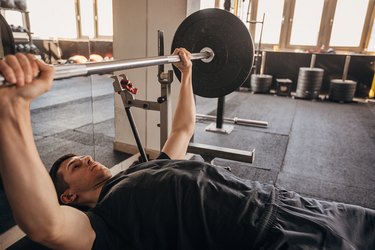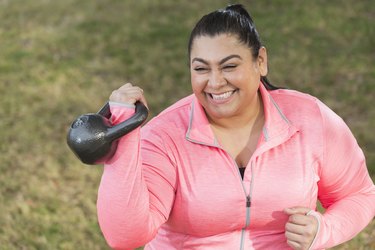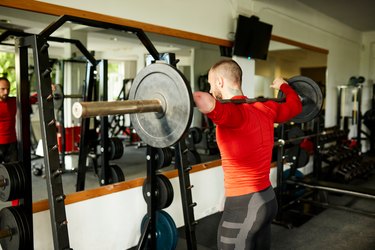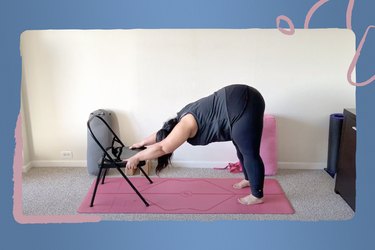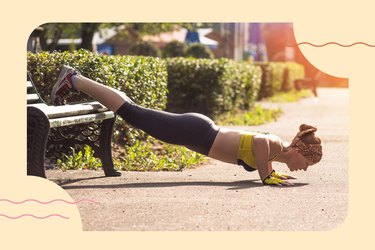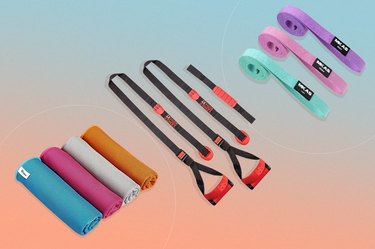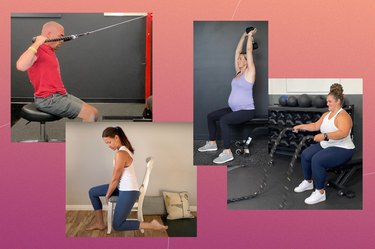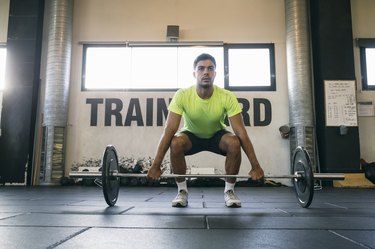
Each semester in my strength and conditioning class, I play a game with my students. I ask two people — one taller, one shorter — to come to the front and do a body-weight squat. As they lower into the squat, the taller person usually pushes their hips far back and tips their chest forward toward the floor. The shorter one keeps their chest up, and their knees go forward past their toes.
Their techniques look totally different. But you know what? Both people have great form.
Video of the Day
Video of the Day
"We all don't have the exact same anatomy," explains Tony Gentilcore, CSCS, a Boston-based certified strength and conditioning specialist. "To expect everyone to squat the exact same way and to expect that it will feel the same is rather narrow-minded."
Yes, there's such a thing as great and not-so-great form, but that doesn't mean there's one ultimate form you need to cram your body into or push through with pain. The best exercise form is always going to be the one that works with your body, not against it.
Not sure how to work with your body? That's OK, we'll teach you here — helping you achieve your goals with as much safety (and fun) as possible.
3 Benefits of Exercise Modifications for Every Body and Level
1. It Can Decrease Your Risk of Injury
There's a reason trainers emphasize form: It help keeps you safe and injury-free. And while following proper form is crucial, when you do exercises without tailoring them to your body, you can experience injury down the line.
For instance, imagine a very tall person trying to do a barbell deadlift. To reach the barbell, this person has to really bend down a lot with each rep, which can put extra stress on the body, especially the lower back. Over time, this can cause pain or injury.
But that doesn't mean tall people can't enjoy the many benefits deadlifts have to offer — a little modification may do the trick. Taking a wider, sumo stance or using a trap bar can help them deadlift with a more upright torso.
2. It Builds a Better Relationship With Exercise
No one loves doing exercises that feel painful, awkward or discouraging. But when you adjust an exercise to suit your body shape and size, you can start to feel more confident. In the long run, this can help increase your consistency with training, according to certified strength and conditioning specialist Patrick Jennings, CSCS.
"We want to increase confidence and competence, increasing consistency," he says. Find exercise modifications and variations that make your workout feel like fun, or even play.
3. It Keeps You Consistent and Progressing
Forcing yourself to do exercises (or variations) that aren't right for your body can slow your progress. And it can be hard to stay motivated and encouraged when you don't see your hard work paying off.
After all, if you force your body into an exercise that you can't do with good form, you're probably not going to get all of strength-building benefits the move has to offer. You may even start to feel aches and pains.
Put simply, we stick with things that are fun, and consistency leads to progress.
3 Factors to Consider When Picking (and Doing) Exercise Modifications
1. Your Body's Proportions
Also known as anthropometrics, your body's shape, size and proportions affect how your body moves.
For example, during squatting-based exercises, people with long legs may feel more comfortable doing single-leg exercises like Bulgarian split squats.
People with heavy weights may find body-weight exercises, like push-ups, chin-ups or planks extra challenging. Modification is the key. Swap planks with a dead bug, opt for a lat pull-down instead of a chin-up, and try a dumbbell press instead of a push-up.
2. Your Injury History
If it hurts, don't do it! Exercise should make your body feel better, not worse (apart from a little post-workout muscle soreness you might feel). Injuries don't necessarily take exercises off the table, but are important to consider as you pick and choose different variations in your workout.
You need to tweak exercises depending on the nature of your past (or current) injury. For instance, someone with an old shoulder injury may feel more comfortable doing their overhead presses at an angle, rather than straight overhead.
Those with previous knee injuries may feel discomfort with a deep squat. But doing a squat onto a box or chair can help control the depth, keeping your knees happier.
What's always a good idea: consulting your doctor or physical therapist before you add any new moves into your workout routine.
3. What You Enjoy Doing
If you can do a squat well and it helps you meet your goals, that's great. But if you can't do a squat variation, maybe it's just not one that has to be in your leg-day schedule. Sub it out for a different squat variation.
Pick exercises that help you meet your goals but are still enjoyable to you.
How to Fit Every Exercise to Your Body
Exercises are categorized by the type of motion you're doing, as listed below. Your weekly strength-training routine should involve exercises within each of these categories to ensure you're hitting all of the muscles across your body.
With that in mind, you can modify or swap exercises within these categories to better suit your body. Although one move in a certain category may not feel too great, there may be another that's more comfortable but still gets the job done.
To select the best exercise variation or tweak for you, the first step is to try out tons of exercise variations and listen to your body. Then, you can play the "if... then" game to narrow down on the best exercise variations and modifications for you.
1. Hip Hinge Exercises
Hip hinge exercises mainly use your glutes and hamstrings to bend then straighten your hips. Deadlift variations make up a lot of the hip hinge exercises out there. So, if the traditional deadlift doesn't feel comfortable, there's no shortage of alternatives.
- If you have a large stomach, consider a wide stance sumo deadlift to make more room for your body
- If you are tall or have a history of back pain, try a trap bar deadlift so you can keep a taller spine.
- If you're new to deadlifts or don't have a barbell, try dumbbell deadlifts and stick with the range of motion that feels good to you.
2. Squat Exercises
Squats train your quads and glutes but also help strengthen your core muscles. They're all about bending at the hips and knees. And, as with deadlifts, there are plenty of squat variations that you can try.
- If you have a big stomach, take a wider stance or try a sumo squat.
- If you have a history of knee pain, try a box squat.
- If you have long legs or lower back pain, consider a split squat.
3. Vertical Push Exercises
These are your overhead pressing exercises (like the shoulder press), which primarily target your shoulder muscles.
- If your lower back arches during shoulder presses, try doing your shoulder presses on an incline bench or try a landmine press.
- If don't have access to or don't want to do standing shoulder presses, do seated ones.
4. Horizontal Push Exercises
Horizontal push moves, like push-ups and chest presses, involve pushing away from your body against resistance. These mainly target your chest muscles.
- If you feel shoulder pain while doing a barbell bench press, try using dumbbells instead so each arm can move more freely.
- If you have wrist pain during push-ups, try holding onto dumbbells to keep your wrist neutral. Or, swap for a dumbbell chest press.
- If you have trouble supporting your body with push-ups, swap it for a dumbbell chest press.
5. Vertical Pull Exercises
Whereas shoulder presses involve pushing overhead, vertical pull moves (like chin-ups) pulling from over your head toward your body against resistance. These target your back.
- If you have shoulder pain while doing a chin-up, try a close (narrow) grip with your palms facing toward your body. Or, swap for a lat pull-down.
- If you can't do a chin-up with your body weight, place your feet on top of a long, looped resistance band for assistance.
6. Horizontal Pull Exercises
Horizontal pull moves, like rows, involve pulling a weight towards your body. These mainly train your back muscles.
- If putting weight on your arm during a single-arm supported dumbbell row hurts, try a single-arm cable row.
- If you have back pain while doing a bent-over dumbbell row, rest your body against an incline bench for extra support as you pull the weight.
7. Carry Exercises
Carry exercises involve walking while carrying a type of weight. The most popular variation is a farmer's walk and these exercises generally strengthen your entire body, including your core.
- If you have shoulder pain, avoid carrying weights overhead or at shoulder height.
- If you have trouble or pain holding onto dumbbells, try kettlebells for an easier grip.
